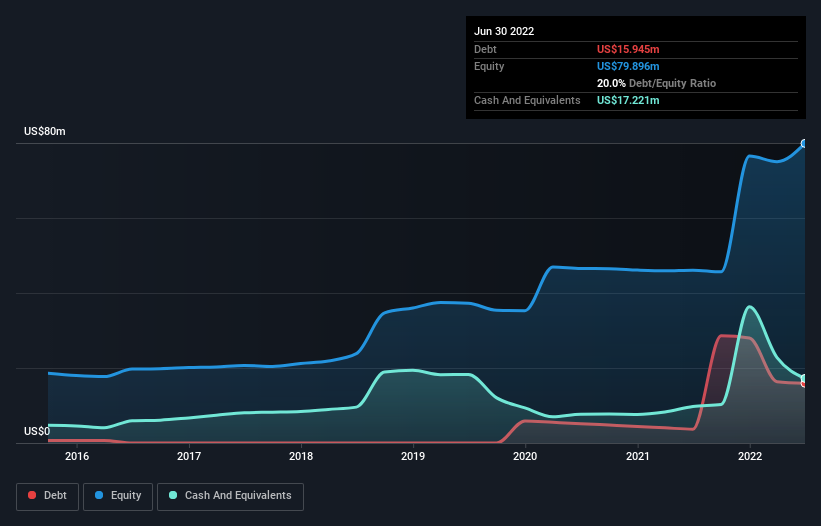Howard Marks put it nicely when he said that, rather than worrying about share price volatility, 'The possibility of permanent loss is the risk I worry about... and every practical investor I know worries about.' It's only natural to consider a company's balance sheet when you examine how risky it is, since debt is often involved when a business collapses. We note that Lantronix, Inc. (NASDAQ:LTRX) does have debt on its balance sheet. But the more important question is: how much risk is that debt creating?
When Is Debt A Problem?
Debt is a tool to help businesses grow, but if a business is incapable of paying off its lenders, then it exists at their mercy. Ultimately, if the company can't fulfill its legal obligations to repay debt, shareholders could walk away with nothing. However, a more usual (but still expensive) situation is where a company must dilute shareholders at a cheap share price simply to get debt under control. By replacing dilution, though, debt can be an extremely good tool for businesses that need capital to invest in growth at high rates of return. When we examine debt levels, we first consider both cash and debt levels, together.
Check out our latest analysis for Lantronix
What Is Lantronix's Net Debt?
As you can see below, at the end of June 2022, Lantronix had US$15.9m of debt, up from US$3.68m a year ago. Click the image for more detail. But it also has US$17.2m in cash to offset that, meaning it has US$1.28m net cash.

A Look At Lantronix's Liabilities
We can see from the most recent balance sheet that Lantronix had liabilities of US$35.5m falling due within a year, and liabilities of US$22.0m due beyond that. Offsetting this, it had US$17.2m in cash and US$29.7m in receivables that were due within 12 months. So it has liabilities totalling US$10.5m more than its cash and near-term receivables, combined.
Of course, Lantronix has a market capitalization of US$170.1m, so these liabilities are probably manageable. But there are sufficient liabilities that we would certainly recommend shareholders continue to monitor the balance sheet, going forward. Despite its noteworthy liabilities, Lantronix boasts net cash, so it's fair to say it does not have a heavy debt load! When analysing debt levels, the balance sheet is the obvious place to start. But it is future earnings, more than anything, that will determine Lantronix's ability to maintain a healthy balance sheet going forward. So if you're focused on the future you can check out this free report showing analyst profit forecasts.
In the last year Lantronix wasn't profitable at an EBIT level, but managed to grow its revenue by 81%, to US$130m. With any luck the company will be able to grow its way to profitability.
So How Risky Is Lantronix?
By their very nature companies that are losing money are more risky than those with a long history of profitability. And in the last year Lantronix had an earnings before interest and tax (EBIT) loss, truth be told. Indeed, in that time it burnt through US$12m of cash and made a loss of US$5.4m. But at least it has US$1.28m on the balance sheet to spend on growth, near-term. With very solid revenue growth in the last year, Lantronix may be on a path to profitability. By investing before those profits, shareholders take on more risk in the hope of bigger rewards. When analysing debt levels, the balance sheet is the obvious place to start. However, not all investment risk resides within the balance sheet - far from it. Case in point: We've spotted 2 warning signs for Lantronix you should be aware of.
Of course, if you're the type of investor who prefers buying stocks without the burden of debt, then don't hesitate to discover our exclusive list of net cash growth stocks, today.
New: AI Stock Screener & Alerts
Our new AI Stock Screener scans the market every day to uncover opportunities.
• Dividend Powerhouses (3%+ Yield)
• Undervalued Small Caps with Insider Buying
• High growth Tech and AI Companies
Or build your own from over 50 metrics.
Have feedback on this article? Concerned about the content? Get in touch with us directly. Alternatively, email editorial-team (at) simplywallst.com.
This article by Simply Wall St is general in nature. We provide commentary based on historical data and analyst forecasts only using an unbiased methodology and our articles are not intended to be financial advice. It does not constitute a recommendation to buy or sell any stock, and does not take account of your objectives, or your financial situation. We aim to bring you long-term focused analysis driven by fundamental data. Note that our analysis may not factor in the latest price-sensitive company announcements or qualitative material. Simply Wall St has no position in any stocks mentioned.
About NasdaqCM:LTRX
Lantronix
Develops, markets, and sells industrial and enterprise internet of things (IoT) products and services in the Americas, Europe, the Middle East, Africa, and the Asia Pacific Japan.
Excellent balance sheet with very low risk.
Market Insights
Community Narratives



